I confess to being puzzled at the attention 'field stripping' gets, compared to 'field assembly'. I'm not the world's handiest guy but I'm nearly always able to make a machine break into its components. It's putting the pieces back together that trips me
By Mark Fenton
Published July 07, 2014
Louis Buchalter: I'm in for killing. What are you in for? Robert Lowell: Oh, I'm in for refusing to kill. —Exchange between Buchalter and Lowell attributed by Ian Hamilton in Robert Lowell: A Biography, 1982.
Samuel Johnson: Patriotism is the last refuge of a scoundrel. —Statement of Johnson on Friday, April 7, 1775, attributed by James Boswell in The Life of Samuel Johnson, 1791.
My daughter is an anthem singer.

The Ohsweken Speedway is her gig.
She gets driven onto the muddy, heavily tread-marked speedway by tractor

and then steps onto the precarious landing just outside the cab. Here she sings "The Star Spangled Banner" followed by "O Canada." Proud father that I am, I photograph her as best I can through the chain-link fence within which participants and anthem singer are imprisoned.
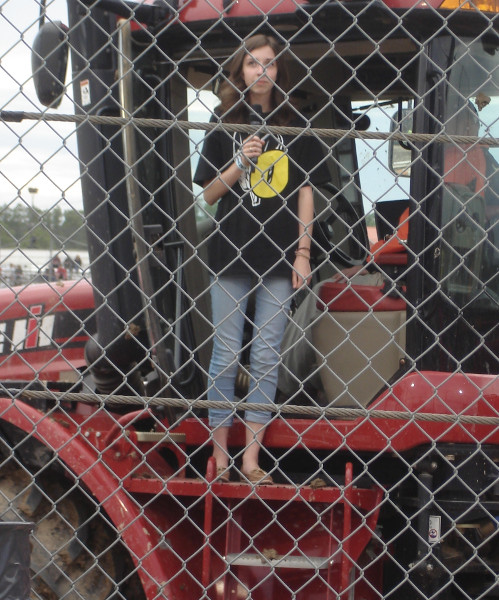
I am so impressed and engaged with the performance that I don't notice until halfway through "O Canada" that I am the only person not standing on guard, and I hope the rest of the audience has deduced that this is my daughter I'm photographing, and don't think my disregard for ceremony is that of a creepy guy who comes to these events to stalk young female anthem singers.
When we were liberal arts undergraduates, students in other faculties would remark on our distressing lack of spirit. We couldn't refute this, nor did we want to. We took the Johnsonian pronouncement as gospel (cavalierly dismissing the first lesson of Logic 101, that "all scoundrels are patriots" does not equal "all patriots are scoundrels.")
We shied away from us-not-them rituals other programs embraced. We visited no hazing upon our freshmen for the privilege of membership. We'd had no discipline-specific song in dubious taste to render with brashness proportionate to our collective level of inebriation. We would receive no pinkie ring, enabling us as postgraduates to identify and nod to a peer at, say, the Ohsweken Speedway.
We saw the seeds of patriotism in these rituals and knew the monstrosities into which they might grow. We were better than that. A my-group-right-or-wrong policy was invitation to the unexamined life, to bitter war, to barely conceivable atrocities. Initiations were bad. Faculty anthems were bad. Exclusive jewelry was bad. We scorned such traditions with savage irony.
Symbolic items like flags and national anthems were tolerated grudgingly. They were larger than anything we could affect, and why add to the conflicts they already perpetuated? I ignored the flag and mouthed the words of the national anthem mindlessly and next to inaudibly. It never occurred to me that hearing an anthem could make me swell with pride as it was now doing.
As we left the Ohsweken Speedway

her mother commented that Nora sang the Canadian anthem with slightly more conviction and emotion than she sang the American. I concurred, and felt that such understated favouritism was altogether fitting and proper, and at the same time it concerned me that I felt this way.
The next morning as I climbed the stairs up from the Waterfront Trail, I continued to ponder the uneasy pride of nationality and patriotic ritual.
Halfway up I crouched down to capture this odd smear of black on the metal riser
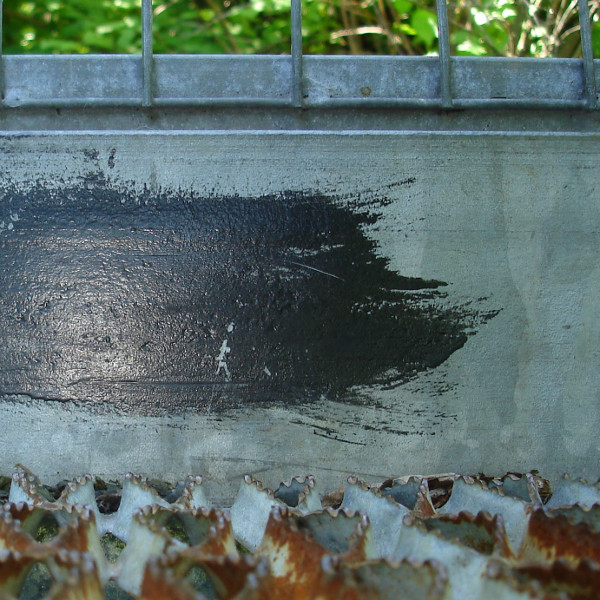
and noted a small figure embedded in the swift gesture of the paintbrush.
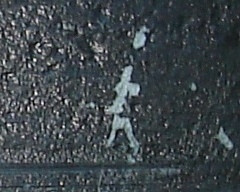
My first thought was of a Giacometti
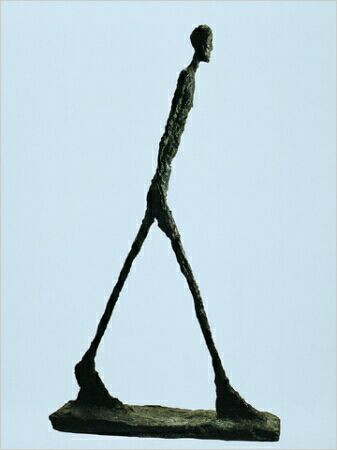
in photonegative, the bumpy black of the figure exploded into the space surrounding it, as though the subject had turned itself inside out from too long a solitude.
I stared deeply at the figurative absence I'd stumbled upon. By a happy accident I had a Sharpie in my knapsack, and I found scrap paper and sketched an imitation of it until meaning emerged.
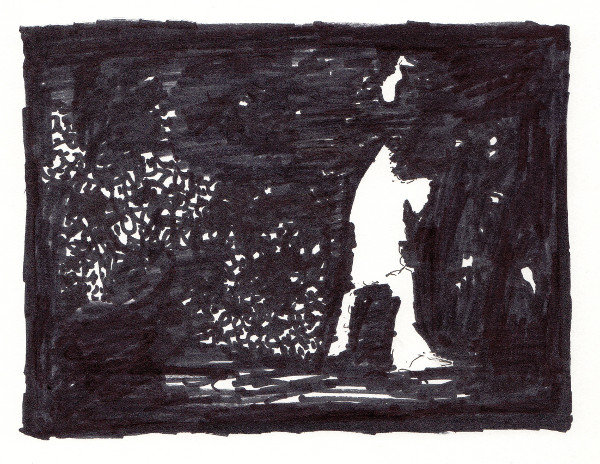
An artist friend once told me that the inexperienced portraitist will always project aspects herself onto her rendition. And that proved to be what I was doing. I am much chubbier than any Giacometti figure and had inadvertently fleshed the found image into a picture of myself.
My sudden desire to observe myself was a revelation. Clearly in my zeal to see, I have forgotten what it means to be seen. I am not an island. Like everyone else I am here to be witnessed and to be judged, as I shuffle daily from pillar to post.
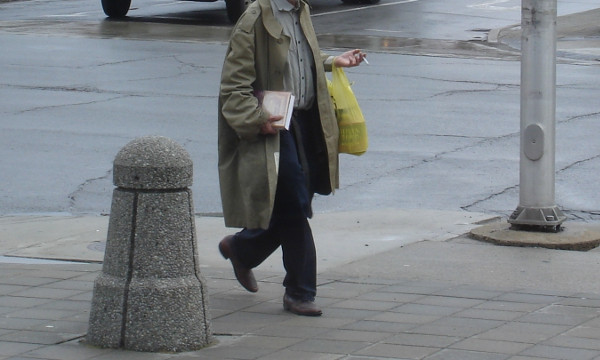
Mark Fenton, as his imagination sees him (photographed from a considerable distance by Mark Fenton)
At this moment I experienced a blinding flash of the obvious. To be human is to be a member of a community, with attendant pride in that community. Raising a flag up a pole isn't necessarily a gesture of superiority. Singing an anthem in an arena isn't necessarily a paean to exclusivity.
I continued my journey across York Street and passed through the graveyard where I paused to photograph a tombstone.
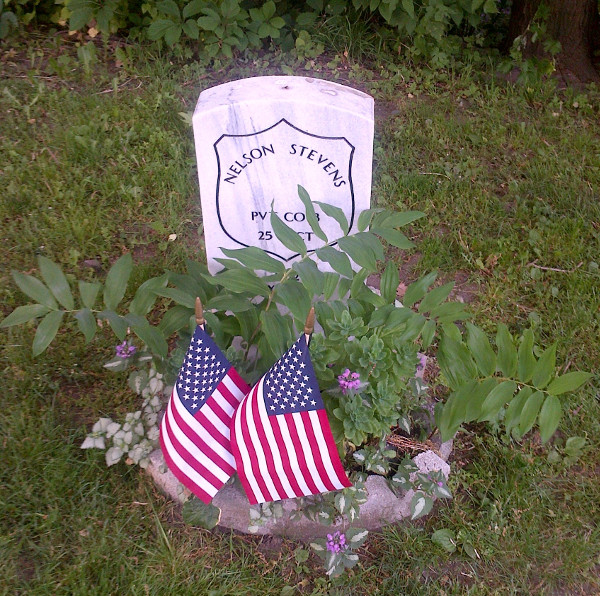
When I got home I needed to find a recording of Robert Lowell reading his poem "Memories of West Street and Lepke," a recording I'd taped off of a borrowed LP sometime in the '80s. I'd seen some of Lowell's readings on YouTube, and as this is one of his most famous poems I didn't think it would be hard to find.
It wasn't there.
It wasn't anywhere on the internet.
This meant I would need to actually find the cassette with the recording.
I still have four drawers full of stuff on cassettes, some dating back to the 70s, I never play them but I've hung onto them in anticipation of a situation like this.
The already shrill discussion around copying recorded material and how this harms the music and film industry went into the red around the time CD burners showed up. For the record, I began robbing the music industry at the age of ten - way back in the analogue era - when my parents gave me a portable cassette recorder with a built-in condenser microphone.
So if I'm opening myself to prosecution by photographing a drawer full of illegal cassettes, I've more than earned it. To say nothing of the fact that I'm referencing a specific recording, which I clearly didn't pay for.
I don't know if there's a statute of limitations. The estate of Robert Lowell may be reading this. They may even apprehend me and prosecute me and deliver me to a prison of political prisoners and gangster and some truly terrible people, who perplex me by not looking terrible at all.
Take heed those of you who rip mp3s. Do you really want to do time for a Justin Bieber track you downloaded illegally when you were 13? Learn from my mistakes. Don't become a statistic.
My tapes are in no order and there is no search engine for their contents. Add to that that my discipline in labeling cassettes was patchy at the best of times.
If you're old enough to remember home taping, you'll probably remember recording something, peeling off that miniscule strip of adhesive-backed paper they supplied you with, applying it to the plastic casing of the cassette, and then writing the artist and title on it in pen, and then when you got bored with what was on Side Two of the cassette you'd record over it with something new and then you'd cross out your previous labeling of artist and title and write the new artist and title in the now almost nonexistent white space, the words so close to illegible at this point that when you got bored and taped over that item you didn't even bother to re-label it, you just kept it in your head.
This leads me to consider the possibility that I've thrown out a mislabeled cassette, not realizing it contained the Robert Lowell recording I suddenly need. There's also the possibility that due to forces beyond my comprehension, a momentary high-powered magnetic field materialized in my attic in the vicinity of the cabinet containing all my cassettes, and erased all the sound from all of them. Which would mean that for years I've been warehousing a cubic meter of cassettes that contain no aural information whatsoever.
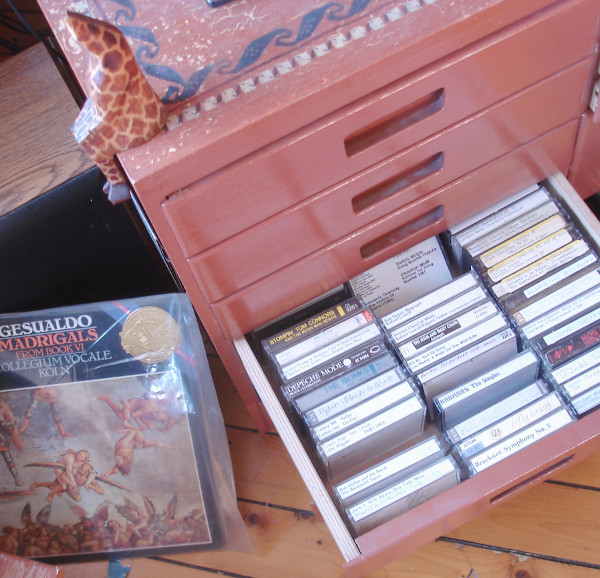
But the god of hoarders proved uncharacteristically benevolent today. I found the tape in seconds. The quality was as good as the average mp3 rip from one of those websites with pop up ads for on-line poker or how to meet singles in your area.
In moments I'd fast-forwarded to the poem in question and pressed play. The take-up wheel engaged the supply-wheel in the slow steady dance of my childhood, and instantly I was a mere three degrees and four decades of separation from a living, breathing Robert Lowell.
Robert Lowell in an echoing room, reading to an attentive crowd who chuckle appropriately at his dry Harvard wit. I won't reprint the poem (which is easily available on-line) but here's an edited version of his ponderous preamble (which isn't.)
... I was in jail as a conscientious objector...and uh...I went to ... the West Street Jail in New York...It had... very powerful people who'd leave the jail everyday with their lawyers. But the most famous inmate was Louis Lepke who was head of Murder Incorporated. And it did just that. You paid Murder Incorporated something and people would disappear. Forever.
Well finally he went to jail...And two or three years later he was electrocuted.
I suppose you all know - I mean often very terrible people don't look terrible at all. He didn't.
Here Lowell begins reading the poem. He refers to the era as 'the tranquilized 50s.' He's living on Boston's 'hardly passionate Marlborough Street'

Robert Lowell home at 239 Marlborough Street (Google Street View)
I've never been to Boston, but I'll go out on a limb and guess that this block of Marlborough Street boasts few residents who've done time.
The action of the poem now shifts back to the early 40s. Lowell recollects the letter he wrote to F.D. Roosevelt refusing military service on learning of the President's decision to bomb civilian targets. This letter leads to Lowell's arrest and sentencing.
The poem then shifts of Lowell's time spent in the West Street Jail, with its motley crew of gangsters and draft evaders. Here Lowell is introduced for the first time to the Jehovah's Witnesses who are eager not to be confused with the Conscientious Objectors, and one of whom teaches him the "hospital tuck." At this point Lowell breaks from the poem with the following digression.
That's been useful to me all my life. That you tuck the ends of the sheet under the mattress and you don't have to make the bed again for a week.
I didn't know how to do the hospital tuck. I headed back to Google.
I quickly found an instructive video on about.com. Introduced thus:
My name is Army Sgt. Shane Medders, and I am stationed in Fort Knox, Kentucky as a drill sergeant.
I urge you got to go to about.com and watch "How to Make a Military Bed with Hospital Corners," and I think you'll find it a lot more rigorous than, "you tuck the ends of the sheet under the mattress."
Drill Sergeant Medders may not be a poet, but he is prepared and articulate and organized and I call his instruction concise and exhaustive. He is uninflected, undigressive, never irreverent. (I fear Sergeant Medders would not like me.)
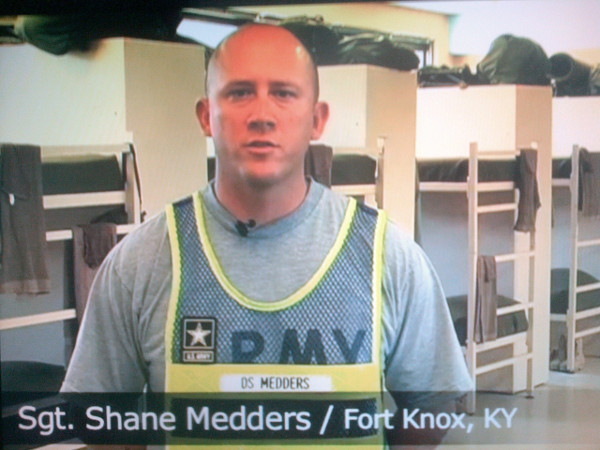
Here is his introduction:
Today we will be showing you how to make a military rack the way we do in the army.
Making a military rack is used [sic] mainly for uniformity purposes[sic slight redundancy] to make sure that everyone is in-line together, all the same [ibid], and for purposes of cleanliness. The army is renowned for their [sic collective noun agreement {I'm really sorry Sergeant Medders but I know you respect rigorous enforcement of standards}] rack making. They are [I'll let this one ride in the interest of good faith between our nations] famous for the hospital corners, and today we will show you how to do that step by step.
Even seeing Drill Sergeant Medders' attention to personal grooming instills a respect for detail and perfection in quotidian tasks. To such a degree that I decided to Google other military instruction videos and typed, 'How to field-strip an M-16.'
The first video that came up was "How To Field Strip AR-15, M-16, M4", which turned out to be a blanket taking-apart-a-gun video. I must say this one is a bit underwhelming. The instructor doesn't give his name or rank, or even show his face. He doesn't even get to his subject until 30 seconds in, and employs tepid adlibs like "don't lose that," when he takes out the retaining clip.
He ends the video with the comment, "To put it back together, just do the opposite."
This video is shorter than "How to make a bed with hospital corners." (!)
I confess to being puzzled at the attention 'field stripping' gets, compared to 'field assembly'. I'm not the world's handiest guy but I'm nearly always able to make a machine break into its components. It's putting the pieces back together that trips me up.
Imagine if Drill Sergeant Medders only showed us "how to strip a military rack with hospital corners," and then said "to make a military rack with hospital corners, just do the opposite."? Tell me if I'm off base here, but "How To Field Strip AR-15, M-16 M4" is about as rigorous as Lowell's "you tuck the ends of the sheet under the mattress..."
Far be it from me to suggest how the US military organizes itself, but if I were a soldier I'd be a whole lot happier if the guys in my unit had a lot of training on how to put a gun together.
Maybe a bed guy like Drill Sergeant Medders needs to do a weekend workshop with the gun guys. Or maybe the bed guys are equally trained in guns and the gun guys are equally trained in beds and all is copacetic. I sure hope so.
The final section Lowell's poem describes Louis "Lepke" Buchalter. Wikipedia is consistent with Lowell's description. (Had I been casting director for a late-80s biopic of Lepke, I'd have gotten Robert De Niro's agent on the phone in a heartbeat.)
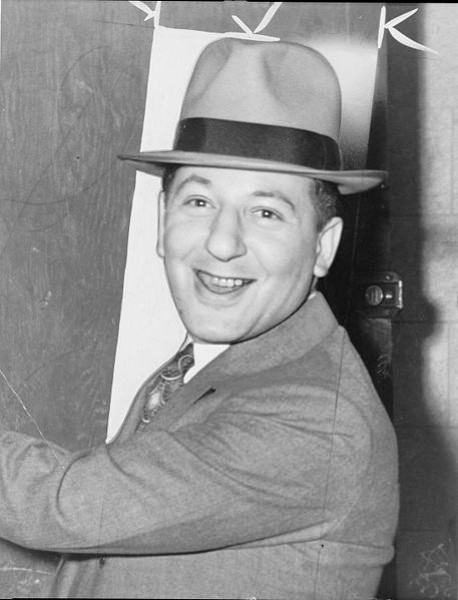
Al Aumuller, World Telegram staff photographer. Library of Congress. New York World-Telegram & Sun Collection.
I think you'll agree that he doesn't look terrible at all.
He came to prominence in the 1920s as racketeer and eventually developed a lucrative business in which he contracted out third party hits for Cosa Nostra. Hits that wouldn't circle back to the client.
Lepke was electrocuted in 1944, a bit sooner than Lowell, imprisoned in 1943 remembers. Lowell's description of Lepke closes the poem.
...dawdling off to his little segregated cell full
of things forbidden the common man:
a portable radio, a dresser, two toy American
flags tied together with a ribbon of Easter palm.
Flabby, bald, lobotomized,
he drifted in a sheepish calm,
where no agonizing reappraisal
jarred his concentration on the electric chair-
hanging like an oasis in his air
of lost connections....
I feel like I have a mouth full of lead whenever I recite these lines, packed as they are with multisyllabic, consonant-heavy modifiers. No wonder they call it "doing time." You feel the weight of it. Second by sluggish second.
But today I'm struck by the flags, and my conflicted thoughts on patriotism and its icons. Lowell is in jail for refusing a patriotic duty. And then he observes Lepke's patriotism in the display of flags on his dresser. Even an utter scoundrel craves a community and its ideals.
A toy tractor might be motorized by springs or a battery, but it's impractical for the purposes of churning up mud or transporting an anthem singer. A toy M-16 may make some noise but it won't release ammunition that penetrates flesh, smashes bone, and ruptures organs.
But what exactly is a toy flag? How does a toy flag fall short of the technical requirements of a "real" flag? In so prolix, and ambitious a poem, it's a deft, easy-to-miss conundrum.
But we all know what he means. We see them in the hands of small children on national holidays, or stuck into the earth around tombstones. Here's a photo I took on Tuesday, July 1st, late in the afternoon as I was leaving the festivities of Gage Park.

To apply Lowell's distinction, the flag hanging tidily in the top right, and the flaccid flag at right centre would be true, regulation, airworthy, adult flags, while the stiff and slightly awry flags in the bottom left would be imitation, frivolous, grounded, 'toy' flags.
I've accepted the importance of national flags in all their abstraction and ambiguity. It's those qualities that make them able to accommodate an evolving sense of nationality, ideals that are always in process and ineffable.
They are antithesis of a military rack with hospital corners, or a well-oiled M-16, which appeal to us as practical things that can be brought to perfection in a world where the big questions remain unanswered.
I had been writing this essay in my car which was parked at Upper James and Rymal. I was hungry. I closed the computer, slid it under the driver's seat, locked the car, and entered a restaurant, to discover a lineup of EMS workers.
I quipped that this would be a good time for me to go into cardiac arrest. To which one of them replied "not really, we're just on lunch and don't even have an ambulance with us." (I'm pretty sure he sensed I was joking. His tone was less humourless than that of, say, Drill Sergeant Madders).
I can't sure he was telling the truth, but I can't blame him if wasn't. They're probably trained to discourage sad and troubled souls from flailing around on the floor like hooked fish just for the attention.
This is the best picture I could get with my phone.
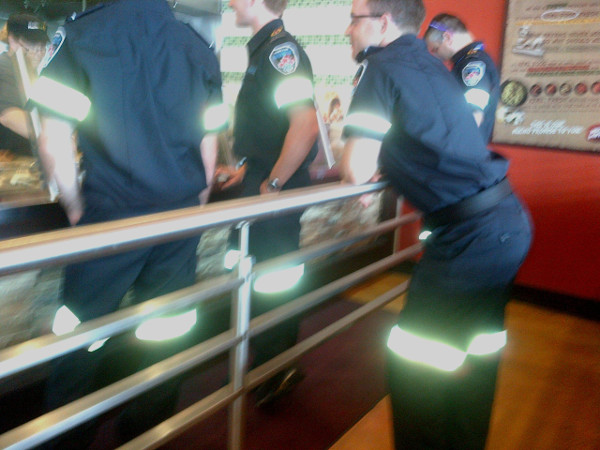
What difference does it make that we can barely see their faces? Courageous and committed people don't necessarily look courageous and committed at all. These men didn't.
The image is so poor I wasn't even going to use it, until it struck me that its fuzzy-dare I say angelic-radiance is how the world would look if I really were to be resuscitated in this room. Light overloading the retina. My vision slowly focusing in an oasis of restored connections.
I imagine an ambient room-tone, swirling into a polyphonic choir that intones all national anthems in perfect harmony with one other. And there the EMS Team stands, effective and glowing.
Having described the official sanctioning of people to kill, and the execution of people who kill without official sanction, it's only reasonable that I also document people who are dedicated to preserving life.
You must be logged in to comment.
There are no upcoming events right now.
Why not post one?